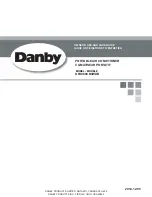
SCS C
ONDENSER
IOM
M
ANUAL
17
Example: Estimate the amount of refrigerant required for a
system using R407C refrigerant consisting of a 5 ton A/C unit
connected with a 1/2” x 30 foot liquid line and 7/8” x 30 foot
discharge line to a SCS-060-SAA -30 °F condenser with
flooded head pressure control and receiver.
A/C Unit
=
5.2 lbs.
+ Condenser w/Receiver
=
12.2 lbs.
+ ½ Liquid Line 30 x 6.51
=
1.953 lbs.
100
+7/8” Discharge Line 30 x 6.51 =
0.873 lbs.
100
Estimated
Refrigerant
Charge
=
20.226 lbs.
Round off to
the
nearest lb>
=
20 lbs.
2.7.3
Preparing System for Charging
1.
With all the system piping connections made, perform a
dry nitrogen leak detection test on the system. Using dry
nitrogen only, pressurize the system to 150 psig. Ensure
all service and solenoid valves are energized open and
that no part of the system is isolated from the pressurized
nitrogen (liquid, suction or discharge lines and reheat coil).
2.
Since there is no refrigerant in the system to detect at
this point, leaks may be detected by observing if there’s
been a change in the standing pressure after 12 hours. A
significant drop in pressure indicates a leak in the system
that needs to be repaired. After the system is determined
to be free of leaks, you may evacuate the system.
EVACUATE THE SYSTEM
CAUTION
A proper vacuum must be drawn on the refrigerant system to
remove moisture prior to charging. If this is not done the
refrigerant charge will combine with moisture in the pipes to form
an acid that will eventually lead to compressor failure. A triple
evacuation procedure with dry nitrogen is recommended
especially for systems with newly installed refrigerant piping.
NOTE: A vacuum pump should be used that can evacuate the
entire volume of the A/C system, including newly installed or
existing piping. It is essential to use a well maintained pump that
is in good operating condition. Always ensure it contains clean,
fresh oil. Change the oil in the pump every 20 minutes to maintain
its ability to remove moisture.
NOTE: Use high quality hoses ensuring they are free of
defects and don’t leak. It is recommended to use
copper tubing instead of hoses if possible due to the
low vacuum that must be attained when evacuating the
system. The use of short, large diameter hoses helps
reduce evacuation time.
3.
After ensuring there are no leaks, relieve pressure and
evacuate the entire system while maintaining all the
solenoids and hot gas reheat valves open. Pull an initial
vacuum of 1500 microns or lower using the suction and
discharge service ports and the service port of the
receiver (if applicable).
NOTE: When pulling a vacuum, the Schrader valves will
unnecessarily restrict the openings, increasing the
evacuation time. During the evacuation process it is
recommended to remove the Schrader valve cores with
a Schrader valve removal tool and draw the vacuum
through the port on the removal tool.
4.
If you cannot evacuate the system below 1500 microns,
close the vacuum pump isolation valve and perform a rate-
of-rise test by observing the standing pressure overtime. If
the pressure rises slowly (up to 200 microns in 15 minutes)
it indicates moisture is in the system that still needs to be
boiled off. Proceed to step #5. If the pressure rises rapidly
up to atmospheric pressure (more than 50 microns per
minute) it indicates a leak that wasn’t detected during step
#2. In this case troubleshoot the entire system for leaks
and repair them. Then begin the initial evacuation process
again starting at step #3.
5.
If no leaks are detected after the initial vacuum, release
the vacuum and pressurize the system with 2-3 lb of dry
nitrogen. Allow the system to stand for two hours with
the dry nitrogen charge. This gives time for the nitrogen
molecules to disperse in the system absorbing moisture.
6.
After two hours, release the pressure. Then turn on the
vacuum pump and evacuate the system a second time
down to 1500 microns or less. Close the vacuum pump
isolation valve and pressurize the system again with dry
nitrogen and allow the system to stand for two hours as
in step #5.
7.
After two hours release the pressure. Turn on the vacuum
pump and complete the process of evacuating the system,
this time with a goal of achieving a 250-micron vacuum
or less. Close the vacuum pump isolation valve. When you
can hold the vacuum at 500 microns or lower for at least
2 hours with no significant rise in pressure, the system is
ready to charge.















































